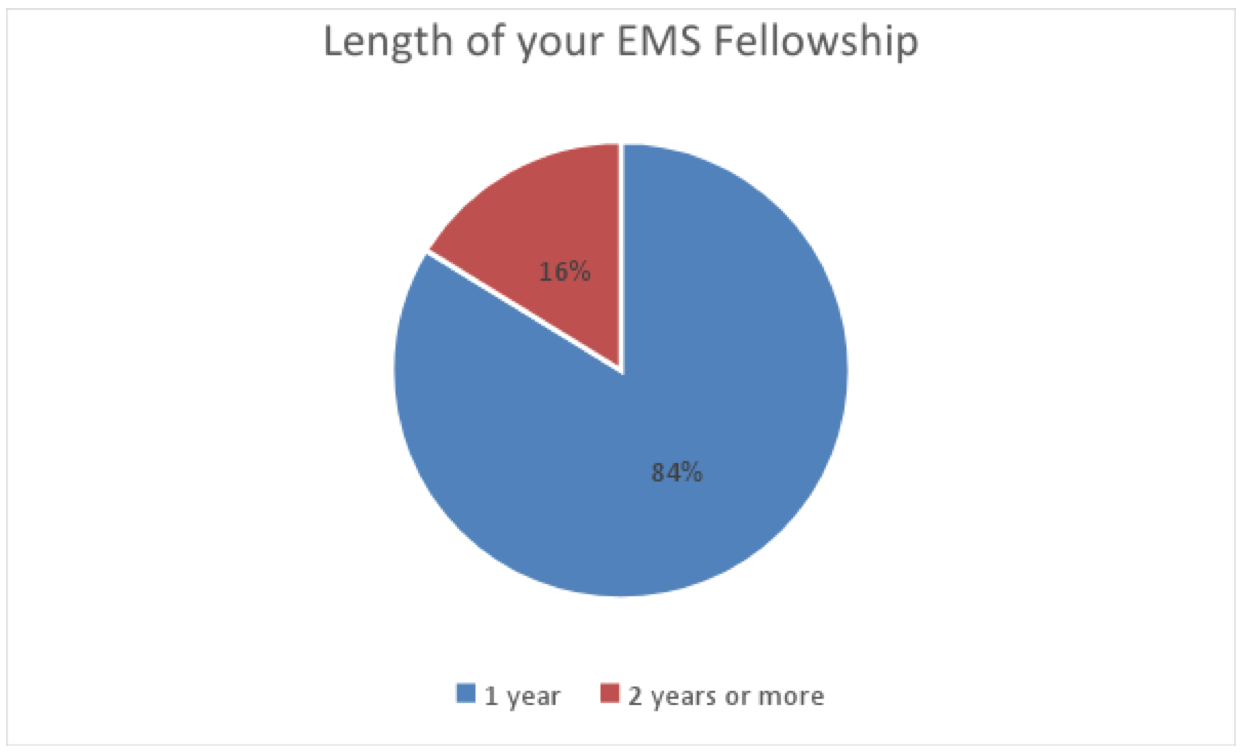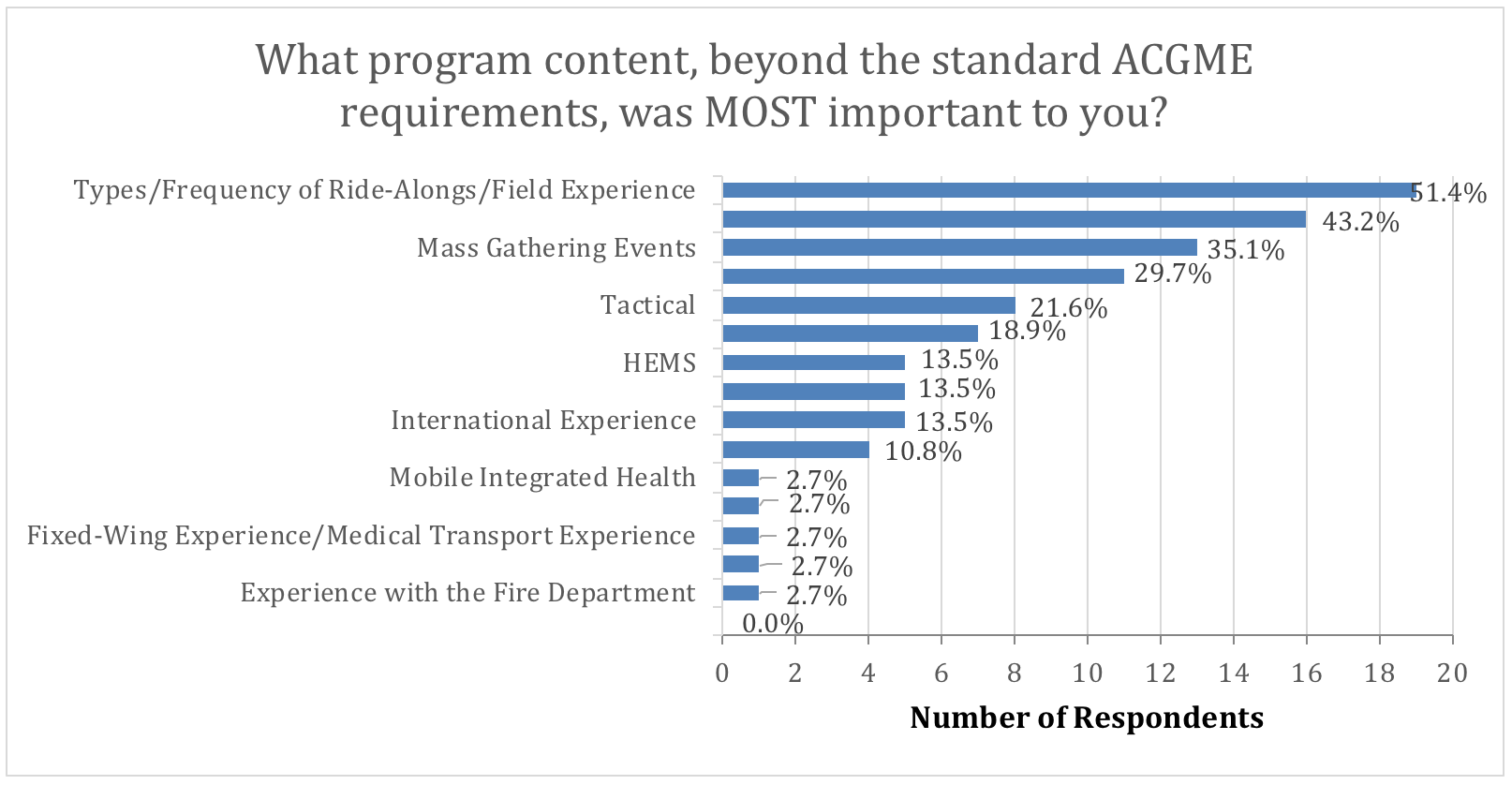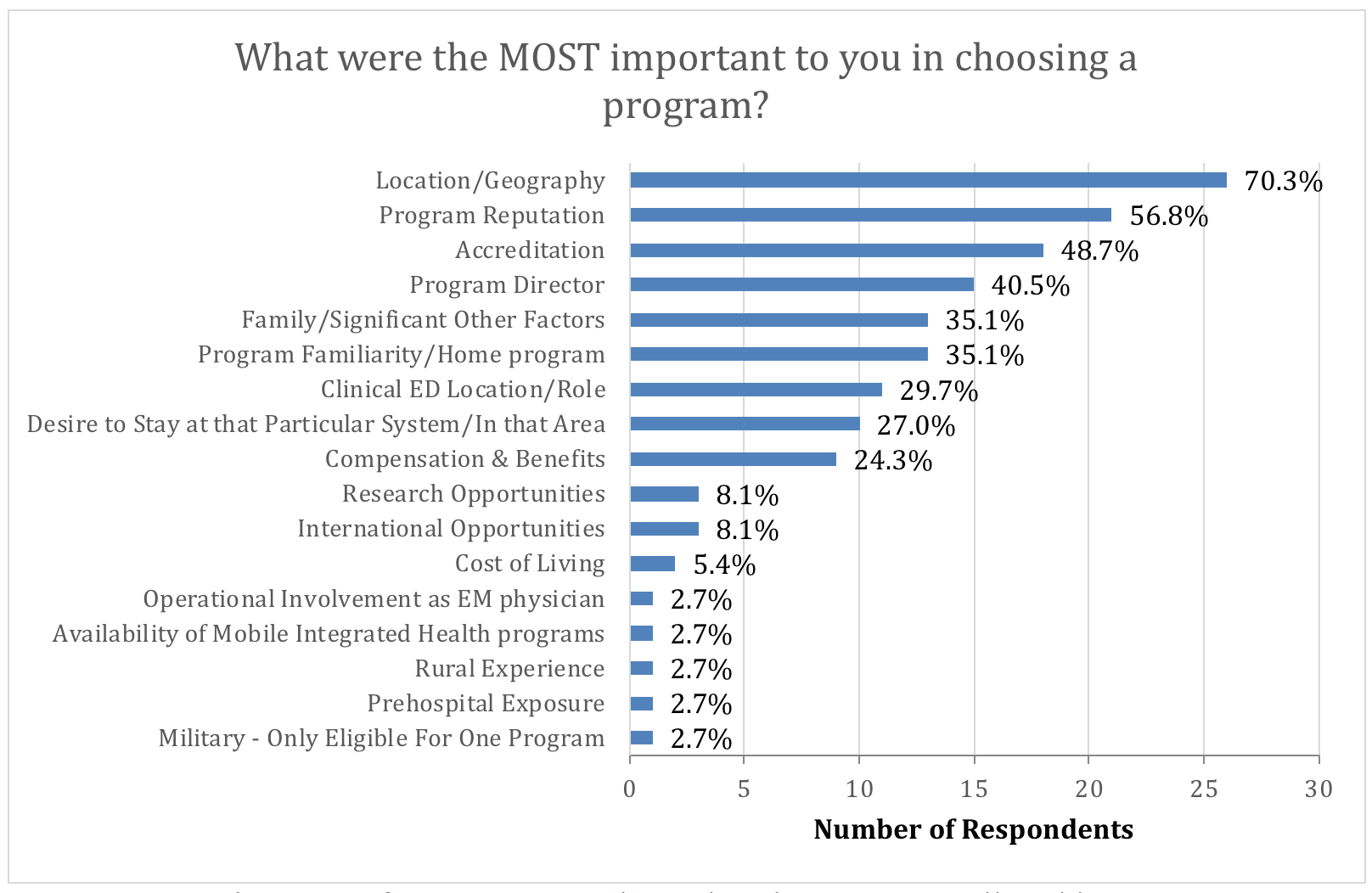Little data exists on the fellowship application process in the growing EM subspecialty of emergency medical services (EMS). A survey of 2017-2018 EMS Fellows sheds light on the factors influencing program selection. We hope this information can help guide the recruitment of future fellows, as well as enable programs to better develop curricula that cater to fellows’ interests.
The survey drew 37 respondents during an academic year with 43 accredited fellows. Results show most respondents used personal networking to find fellowships (78.4%), location was the most influential determinant (70.3%), and a majority of interviews occurred in September.
Introduction
Fellowship recruitment strategies vary tremendously across all fields of medicine. EM fellowships are relatively new compared to many of the other fellowships in long-standing fields of medicine such as internal medicine or surgery. Specifically, the American Board of Emergency Medicine (ABEM) first offered the Emergency Medical Services Fellowship board examination in October 2013, recognizing a new but critical area of expertise within emergency medical care.
Since 2013, several EMS Fellowship programs, both accredited and unaccredited, have been created. Currently, the supply of training positions outnumbers fellow applicant demand.1 Thus, it has become of great interest to evaluate factors and resources motivating residents’ choice between programs, both for initial application and final selection.
Review of current literature did not reveal any studies or surveys on such topics. Our goal as recent EMS Fellow graduates and/or those interested in EMS education is to better understand the tools and decision making process current EMS Fellows use to help each training site develop curriculum and programs directed at the general interest of fellows, and assist in the recruitment of fellows by enabling faculty to focus efforts on tools or search engines most frequently employed by fellow applicants. It may also be used as evidence to increase EMS education during residency as this initial educational material can help with early interest and recruitment amongst Emergency Medicine residents. Our goal as part of the sub-committee of EMS Fellows and Recent Graduates of the National Association of Emergency Medical Services Physicians (NAEMSP) is to acquire information helpful to the development of training programs and create a baseline for future studies as this process evolves and changes. This data also evaluates the number of interview offers, number of interviews accepted, and timing of such interviews of the most recent class of EMS Fellows.
Materials and Methods
A 9-question, Google-based survey was created. Eight of these questions were directed answers, and the last question was open-ended. With the help of a member of the Council of EMS Fellowship Directors, the survey link was sent to all participating EMS Fellowship directors via an email list serve with an explanation and instructions to pass along to current fellows in the training program for the academic year 2017-18. Approximately 6 weeks were allotted for completion of the survey, with a series of 3 staggered reminders for completion.
All data was collected via the secured Google-based survey system, and at no point was any identifying information about demographics of training site or a particular fellow acquired. This includes no distinction between accredited and unaccredited training programs. The raw data was then reviewed, assessing for any unusual trends or inappropriate comments in the open-ended question. The data acquired was then placed in graphical form via Microsoft Excel. Comments in the open-ended question were left in raw format, both in order of receipt and grammatically.
The ordered questions were as follows:
- What sources did you use to find fellowships? (Check all that apply)
- To how many fellowships did you apply?
- How many interviews were you offered?
- How many interviews did you accept?
- During which month(s) were the majority of your interviews? (Check all that apply)
- Length of your EMS Fellowship?
- What were the MOST important to you in choosing a program? (Check all that apply)
- What program content, beyond the standard ACGME requirements, was MOST important to you? (Check all that apply)
- What advice would you give to current senior residents looking into EMS Fellowship programs?
Results
During the survey period, 37 responses were acquired of a possible 43. Seventeen applicants applied and interviewed at only one program. The others applied to a range from 2 to 8 programs, and most accepted the interviews offered. Twenty applicants attended only one interview, while the others attended a range from two to eight interviews. Of the 37 responses, 15 individuals offered a statement to the open-ended question 9.
Open-ended comments included advice on choosing which programs to apply to, such as:
- “Do research on what each program has to offer.”
- “Look at several different programs so you get what you want.”
- “If you have a certain focus/interest within EMS, see what programs offer opportunities in this focus.”
- “Apply early as possible to ensure you are able to see multiple program offers.”
- “Identify what things you’re looking for most and design your search around those.”
There were also comments regarding the interview such as:
- “Make sure you speak to current and former fellows regarding the experience, so you know what to expect from the fellowship.”
- “Interpersonal relationships at the chosen institution are important, get a good feel for them during the interview.”
- “Start early, spend time in the area before and after your interview, talk to current fellows.”
Several comments addressed choice of offers and general advice:
- “Find one where you fit with the faculty and EMS system.”
- “Look for a place you’d be interested in working after and where you get along well with the Department.”
- “Go where you will be happy and where you get a good vibe.”
- “Don’t get scared/bullied into taking a spot at a program that doesn’t fit well for you just because they offer a position early.”
Discussion
This study demonstrates many different areas EMS Fellowship applications focus on, as well as the trends of the system itself for interviewing residents. In terms of the search process for EMS Fellowships, it is clear the most common resource used was personal networking (78.4%), followed by a triad cluster of individual fellowship program websites (54.1%), the NAEMSP Fellowship page (45.9%), and search engines (40.5%).
It also relates the importance of offering interviews. As shown in the preceding data, many candidates had greater than 3 interviews, most of whom attended all of the offers. Clearly if a program is interested in a candidate, the data suggest it should offer an interview, regardless of how likely the program feels the candidate is to actually choose the program prior to the interview. Most interviews are offered early in the academic year, with more than 40% of respondents stating a majority of the interviews occurred in September.
Regarding program choice, three factors stand out as indicated by fellows. Location and geography was cited by 70% of current fellows, 56.8% used program reputation in the decision making process, and 48.6% assessed programs’ accreditation status. The importance of geography is particularly interesting since nearly 1 out of 6 fellows is in a 2-year program, which appeared to be secondary to favorable location for those programs.
There were also 4 areas of program specifics beyond Accreditation Council for Graduate Medical Education (ACGME) requirements that current fellows indicated were most important. Types/frequency of ride-alongs/field experiences proved the most significant, followed closely by the presence of a dedicated vehicle for EMS response, mass gathering events, and the title/role of medical director assistant or associate medical director during fellowship. Cost of living and research opportunities were not popularly considered when choosing a program. This is despite the research requirements for program accreditation.





Survey Notes
Data collection via the Council of Fellowship Directors listserve presents potential for bias. This list reflects programs that have a stronger NAEMSP presence, and so responses from fellows at these programs may reflect inherently different preferences when choosing a fellowship.
During the 2017-18 academic year, there were 57 accredited EMS Fellowship Training programs, with 43 fellows total. Our survey was limited to only 37 participants. Since we do not have access to any ACGME listserve to capture all accredited fellows, this limitation is difficult to overcome. Participation is voluntary from the list serve above, and requires the program director to send the survey to current fellows. There is no distinction between application to accredited fellowships and unaccredited fellowships. This makes the specific responses more difficult to directly apply to a program, given it is not delineated whether the sources or interests a candidate noted were for an application to an accredited and unaccredited (or both) fellowship.
Correlations of responses within questions can also be unclear. In question 1, the most prominent response was personal networking as the primary resource used to research fellowships. It is thus highly probable that individuals within the personal network directed potential candidates to certain programs, artificially inflating the second most common resource, the use of individual Fellowship websites. Regardless of use of program-specific websites as a primary or secondary resource, it does highlight the importance of website upkeep and user-friendliness to training programs desiring to attract candidates.
Also, all respondents in our surveyed group placed into fellowship. There is no data on interests or other information from those who may have applied for fellowship and did not receive an offer which was subsequently accepted. Lastly, open-ended questions in terms of choosing all answers that apply make it difficult to assess which of the options was the most significant. Rather, this data set identifies the most common option across all respondents, regardless of which truly was the most significant. Overall, we hope this data can provide a starting point for future surveys to improve the current EMS fellowship system, from application process to program.
Special Thanks
We would like to send a special thanks to Stacy Weisberg, MD, FACEP, who greatly facilitated acquisition of this data. It would not have been possible to perform this study without her generous gift of time and resources.
Key for images
NAEMSP = National Association of Emergency Medical Services Physicians
EMRA = Emergency Medicine Residents’ Association
ACEP = American College of Emergency Physicians
AAEM = American Academy of Emergency Medicine
ACGME = Accreditation Council for Graduate Medical Education
HEMS = Helicopter Emergency Medical Services
MBA = Master's of Business Administration
MPH = Master's of Public Health
References
- Accreditation Council for Graduate Medical Education. Accreditation Council for Graduate Medical Education (ACGME) – Public search engine. Accessed January 2018.
- American Board of Emergency Medicine. EMS Overview. Accessed January 2018.
- DeSantis M, Marco CA. Emergency medicine residency selection: factors influencing candidate decisions. Acad Emerg Med. 2005;12(6):559-61.
- Laskey S, Cydulka RK. Applicant considerations associated with selection of an emergency medicine residency program. Acad Emerg Med. 2009;16(4):355-59.
- Love JN, Howell JM, Hegarty CB, et al. Factors that influence medical student selection of an emergency medicine residency program: implications for training programs. Acad Emerg Med. 2012;19(4):455-60.
- St Amour BA. Factors important to applicants to osteopathic versus allopathic emergency medicine residency programs. West J Emerg Med. 2014;15(2):184-7.
- Wadman MC, Hoffman LH, Erickson T, Tran TP, Muelleman RL. The impact of a rural emergency department rotation on applicant ranking of a US emergency medicine residency program. Rural Remote Health. 2007;7(4):686.
- Yarris LM, Deiorio NM, Lowe RA. Factors applicants value when selecting an emergency medicine residency. West J Emerg Med. 2009;10(3):159-62.



